

"The Hard Truths of Academic Leadership" The Alpha Sigma Alpha chapter at YCP. Hurdle #1: Getting in the Door. Award-Winning Approaches to Retention. Our Scholars — The Posse Foundation. DSBReport. EJ877254. File49754. Reaching out, but in which direction? – academic outreach programs – includes list of MESA USA members. PUTTING FIRST-GENERATION STUDENTS FIRST.
By Dina M.

Horwedel Faced with a growing population of first-generation students, many colleges are undertaking unique initiatives to recruit and retain these students. As the demographics of the United States change, it’s only natural that enrollment in the nation’s colleges and universities mirrors these shifts. One well-reported trend is the growing Hispanic population, which is resulting in a greater number of first-generation college students. Institutions of higher education across the country are creating and revamping programs to serve these students in efforts to increase their chances of obtaining a degree.
Dr. “Over the last two decades we have seen tremendous growth among Latinos in higher education,” Hurtado says, noting that her research looked at trends in access for four-year institutions from 1975-2006. Majority Minority California State University, Dominguez Hills, has a majority minority student population. College Completion Movement Helps Spur Academic Intervention Program Innovations. By Reginald Stuart BALTIMORE — When Coppin State University officials told a group of incoming freshmen they had to attend a six-week summer pre-college program before enrolling this fall, the idea of more school was the last thing on some students’ minds.
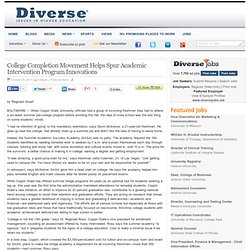
“I had no intention of going” to the mandatory orientation, says Devin McKeiver, a 21-year-old freshman. He grew up near the college, had already lined up a summer job and didn’t like the idea of having to leave home. Indeed, the Summer Academic Success Academy (SASA) was no party. A Bridge to the Community. By William J.
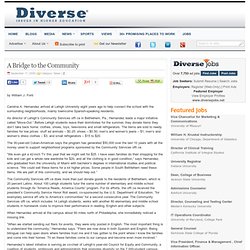
Ford Carolina A. Hernandez arrived at Lehigh University eight years ago to help connect the school with the surrounding neighborhoods, mainly lowincome Spanish-speaking residents. As director of Lehigh’s Community Services offi ce in Bethlehem, Pa., Hernandez leads a major initiative called “Move-Out.” Multiculturalism, Universalism, and the 21st Century Academy. The following essay was adapted from the author's keynote address at for the Future of Minority Studies Summer Institute Colloquium, at Stanford University last month.
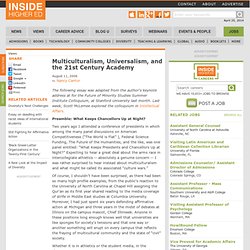
Last week, Scott McLemee explored the colloquium in Intellectual Affairs. Preamble: What Keeps Chancellors Up at Night? Two years ago I attended a conference of presidents in which among the many panel discussions on American Competitiveness (“The World is Flat” ), Federal Science Funding, The Future of the Humanities, and the like, was one panel entitled: “What Keeps Presidents and Chancellors Up at Night?” Expecting to hear a great deal about the arms race in intercollegiate athletics -- absolutely a genuine concern -- I was rather surprised to hear instead about multiculturalism and what might be called its associated “culture wars.”
For not being surprised doesn’t mean we can stop talking about it. Taking Groups Seriously. Redefining Access and Success. College and university leaders are regularly criticized for making too little information available or presenting only the data that show them in the best light.
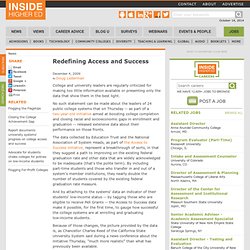
No such statement can be made about the leaders of 24 public college systems that on Thursday -- as part of a two-year-old initiative aimed at boosting college completion and closing racial and socioeconomic gaps in enrollment and graduation -- released extensive data about their performance on those fronts. The data collected by Education Trust and the National Association of System Heads, as part of the Access to Success initiative, represent a breakthrough of sorts, in that they suggest a path to improving on the existing federal graduation rate and other data that are widely acknowledged to be inadequate (that's the polite term).
The more realistic picture is not necessarily a pretty one, though. Pipelines Into Partnerships. As we end the admissions cycle for the entering class of 2010, I have started thinking about new ways of approaching this process at the institution I lead.
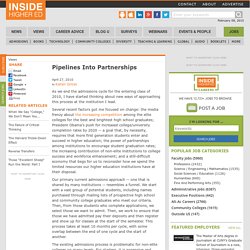
Several recent factors got me focused on change: the media frenzy about the increasing competition among the elite colleges for the best and brightest high school graduates; President Obama’s push for increased college/university completion rates by 2020 -- a goal that, by necessity, requires that more first generation students enter and succeed in higher education; the power of partnerships among institutions to encourage student graduation rates; the increasing contribution of non-elite institutions to college success and workforce enhancement; and a still-difficult economy that begs for us to reconsider how we spend the limited resources our higher education institutions have at their disposal.
Our primary current admissions approach -- one that is shared by many institutions -- resembles a funnel. Unexpected First Generation Path. When it comes to enrolling, retaining and graduating first-generation college students, many people first think about community colleges and public institutions that focus on serving working-class students.

While those institutions, indeed, do attract many first-generation students, some small private institutions are hoping some of these same students will consider their colleges instead. Study aims to learn why some black men succeed in college. The litany of bad news about the status of black men in higher education is by now familiar.

The Uses of January. I’m wondering if there are other productive ways of using January.
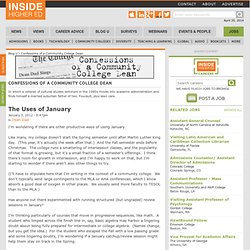
Like many, my college doesn’t start the Spring semester until after Martin Luther King day. (This year, it’s actually the week after that.) And the Fall semester ends before Christmas. The college runs a smattering of intersession classes, and the popularity of that format is growing, but it’s a small fraction of a semester’s offerings. Learning Communities, Student Success, and Real Pizza. I spent Thursday at the “Strengthening Developmental Education” conference presented by the MDRC at Columbia University in a shockingly hot New York City.
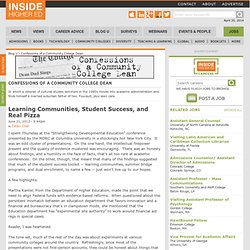
It was an odd cluster of presentations. Gaining and maintaining momentum is key to student completion (essay) Newton’s First Law of Motion states that an object at rest tends to stay at rest and an object in motion tends to stay in motion, and once in motion, that is when it develops momentum. It will tend to stay in motion unless acted upon by an external force. Elucidated by Newton in 1687, the first law of motion can also be applied to study of student completion, for like objects, students at rest tend to stay at rest and students in motion tend to stay in motion. Once they gain momentum (that is, acquire more degree credits), they are more likely to stay in motion unless acted upon by an external force.
Gaining and maintaining momentum is key to student completion. More data show students unprepared for work, but what to do about it? As more students have struggled to find a place in a depressed job market and questions about the employment value of a college degree have intensified, so too has concern that new graduates are not equipped to function in the work place and are not meeting employers’ expectations. A new survey reaffirms that quandary, but the group that commissioned it hopes the findings actually teach students something. “We’re going to go directly to students and help them understand what this gap is,” said Dan Rosensweig, president of the learning company and textbook rental giant Chegg, which runs a service connecting graduating high school students with colleges and scholarships.
“We appreciate the fact that this dialogue is going on right now. We thought, however, that somebody really needed to frame what the issues really are and what is addressable, and help figure out the best way to address it.” Summer Bridge Helps Community College Students Pass Math and Writing. Study Suggests Summer 'Bridge' Programs Help Black and Hispanic Men Earn Better Grades. A new national study of male students who are black or Hispanic suggests that they get better grades in college if they go through college-preparatory outreach programs before their freshman year. Terrell L. Strayhorn, an assistant professor of higher education and sociology at the University of Tennessee at Knoxville, conducted the study by analyzing data on black and Hispanic males collected as part of the U.S. Education Department’s National Education Longitudinal Study. He found that those who had gone through “bridge” programs intended to help their transition to college went on to earn higher grades than comparable students who lacked such additional college preparation.
On most college campuses, the difference between the two groups was equivalent to the difference between a C+ or B- grade-point average and a solid B average, Mr. Mr.